Hope I didn't kill your appetite with that analogy (sorry). Anyway here's my solution: make him cut all the fat off.
Yes this week I had a helper. Since I don't really mind a little bit of fat here and there and Martin does, I figured it was fair to ask him to do all the grunt work. Photos to follow.
Anyway as far as the meal goes this week, I have to admit, I feel a little cheated. I'm not sure the main course was really from Cote d'Ivoire. I guess I'm not really qualified to say for sure one way or another, but I've prepared enough African meals by now that I kind of know what to expect. And this was not what I expected.
Let me back up first and tell you a couple of things about Cote d'Ivoire. You're probably more familiar with its older name, Ivory Coast, which the government has kindly requested that the rest of the world no longer use, though "Ivory Coast" is really just a literal English translation for the original French Cote d'Ivoire. The name comes from—you guessed it—the ivory trade, which was the main export in that region during the 15th and 16th Centuries, when the French claimed much of the region.
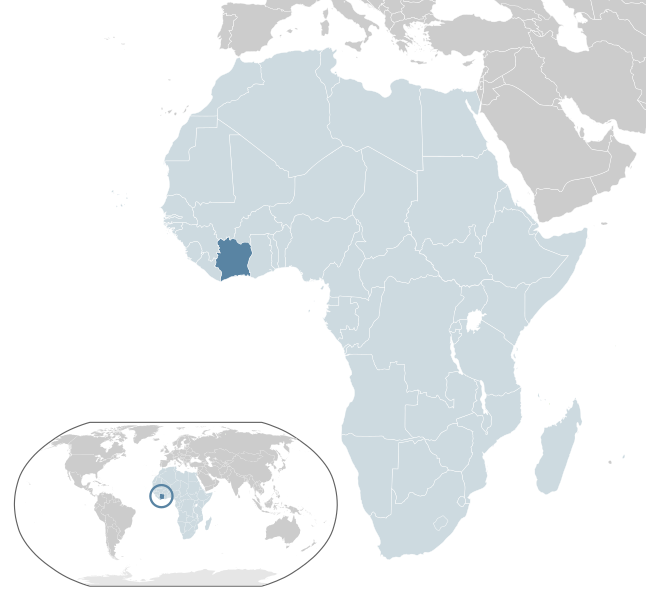
Today the primary exports are coffee and cocoa (my favorites!) so the area does have a few things going for it, not the least of which is a higher per-capita income than many other African nations, and the impressive distinction of being the largest economy in the West African Economic and Monetary Union. But like other developing countries, Cote d'Ivoire also suffers from institutional corruption and political disputes stemming at least in part from a relatively recent civil war.
If you read the Wikipedia entry for cuisine in Cote d'Ivoire, which I did not do until about 10 minutes ago, you will see that typical fare in this African nation consists of stuff like cassava, plantains, peanuts and corn. Which is part of the reason why I'm now scratching my head over the menu I eventually went with. But, what's cooked is cooked, so in the spirit of full disclosure I will carry on with this entry as usual, and then place this one on my list of possible do-overs.
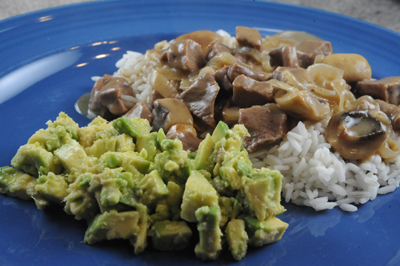
Here's the first, and strangest of the dishes I chose:
Blanquette d'Agneau au Curry (Curried Blanquettes of Lamb)
- 2 lbs lamb, cut into large cubes
- 2 carrots, peeled
- 1 leek, washed and trimmed
- 1 onion
- 1 clove
- 7 oz shallots
- 9 oz button mushrooms
- 1 1/8 cup crème fraiche
- 3 1/2 tbsp butter
- 1/2 cup plain flour
- 2 tbsp peanut oil
- 1 stock cube
- 2 tbsp curry powder
- 1 bouquet garni*
- salt and freshly-ground black pepper, to taste
This recipe came from Celtnet, so there's another reason to be suspicious.
The second recipe, also from Celtnet:
Avocats au Gingembre (Gingered Avocados)
- 2 avocados
- juice of 1 lime
- 2 tbsp freshly-grated ginger
- salt, to taste
And for dessert (Yes, also from Celtnet. Sigh.):
Gâteau Molleux à l'Ananas et à la Noix de Coco (Soft Cake with Pineapple and Coconut)
- 10 1/2 ounces fresh pineapple pieces with reserved juice
- 1/2 cup grated coconut
- 1 1/2 cups all-purpose flour
- 2/3 cup caster sugar
- 3 eggs, beaten
- 1/2 cup butter
- 1 tsp baking powder
- pinch of salt
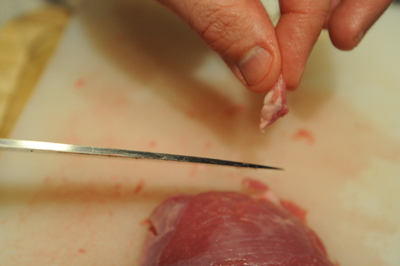
Now, cut the lamb up into bite-sized pieces and put them in a pot with the carrots and the leek (you don't have to chop the vegetables, but remember that leeks can be really dirty so make sure you wash it well). Now crumble up the stock cube and add the bouquet garni (I just used a tea ball with some dried herbs in it, since I didn't have any fresh on hand). Now stick the clove in the onion and toss that in, too.
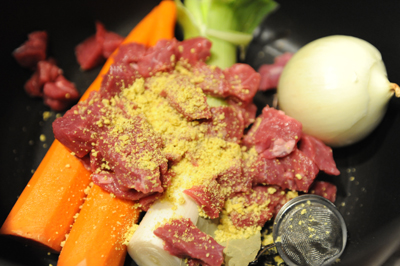
Add salt and pepper and just enough water to cover.
Bring to a boil, then reduce heat and cover the pot. Simmer until the meat is very tender (at least 2 hours). Strain and reserve the stock and set the meat aside.
Peel the shallots (the recipe didn't say what to do with them after peeling, so I just sliced them since cooking them whole didn't seem right).
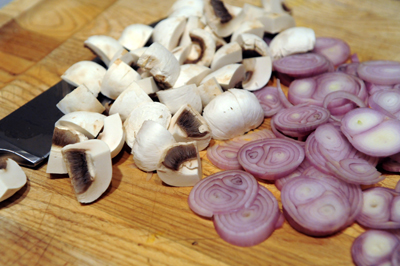
Heat the oil over low heat and fry the mushrooms with the shallots until they start to turn a nice golden brown color.
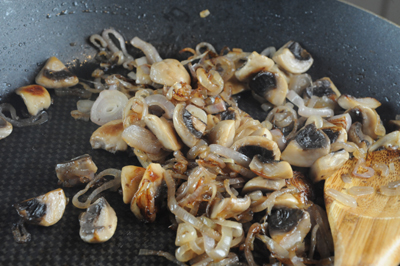
Now melt the butter and add the flour to make a roux. Stir for about two minutes, then add the curry powder and remove from the heat. Let cool.
Whisk the reserved stock into the roux. Bring back to a simmer, then add the crème fraiche, the lamb pieces and the onions and mushrooms. Bring back to a simmer and cook for another 15 minutes, adding seasonings if needed. Don't let the pot boil. Serve with boiled white rice.
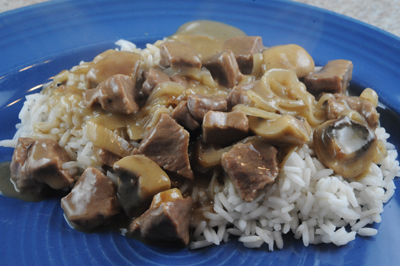
Meanwhile, make the avocados. First mix the lime juice with the grated ginger and salt. Then cut your avocados up into a fine dice. Mix and toss. Cover and refrigerate for at least an hour. That was easy!
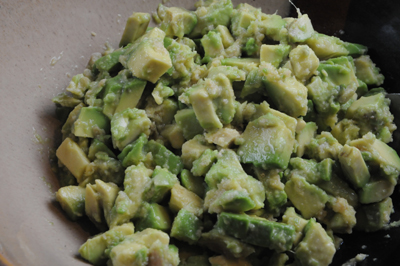
Finally, here's how to make the cake:
Preheat your oven to 400°, then grease and flour a spring-form cake pan and set aside. Now melt the butter and add to a large bowl with the coconut. Add the sugar and eggs.
In another bowl, sift the flour together with the baking powder and salt. Add to the first bowl and mix well.
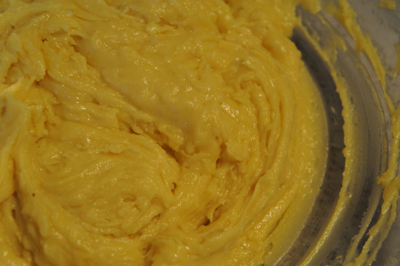
Now fold in the pineapple and reserved juice.
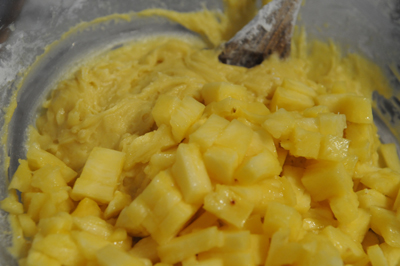
Transfer the batter to the prepared cake pan and bake for 20 minutes or until a toothpick inserted into the center comes out clean. The cake should be turning a golden-brown color on top. Remove from the oven and let cool for 10 minutes before releasing the pan. Serve.
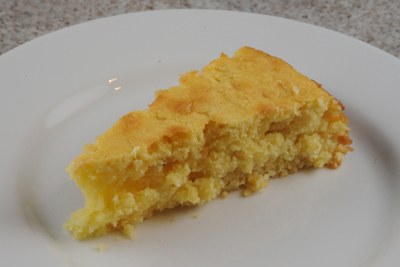
So here's the verdict on the main course: it was lamb stroganoff. With a hint of curry. It was a really, really lean lamb stroganoff, because Martin takes his fat-removing job very, very seriously. But yes, it was a stroganoff. It was fine served with rice but honestly, it really belonged with some hot buttered cabbage noodles from Hungary. (I have a great recipe if you want one.) It really did not seem like an African dish, though I will say that it was tasty, just not, you know, African. Or at least it didn't seem that way to me.
The avocados were good, really good, actually, but as I said earlier they were not appropriate as a side dish for the lamb. They would have been pretty nice as an appetizer, served with some bread to take the edge off (they were really strong in flavor; the lime and ginger proved to be a very potent combo).
The coconut and pineapple cake was, well, it was cake. We all loved it, my husband in particular. The best part about it was the really crispy crust that formed on top while it was baking, combined with the soft interior.
So it was an interesting meal, but I do feel like I probably didn't get Cote d'Ivoire right. Hopefully someone will email to set me straight. That's really the best was to get authentic recipes, anyway.
Next week: Croatia
For printable versions of this week's recipes:











0 comments:
Post a Comment